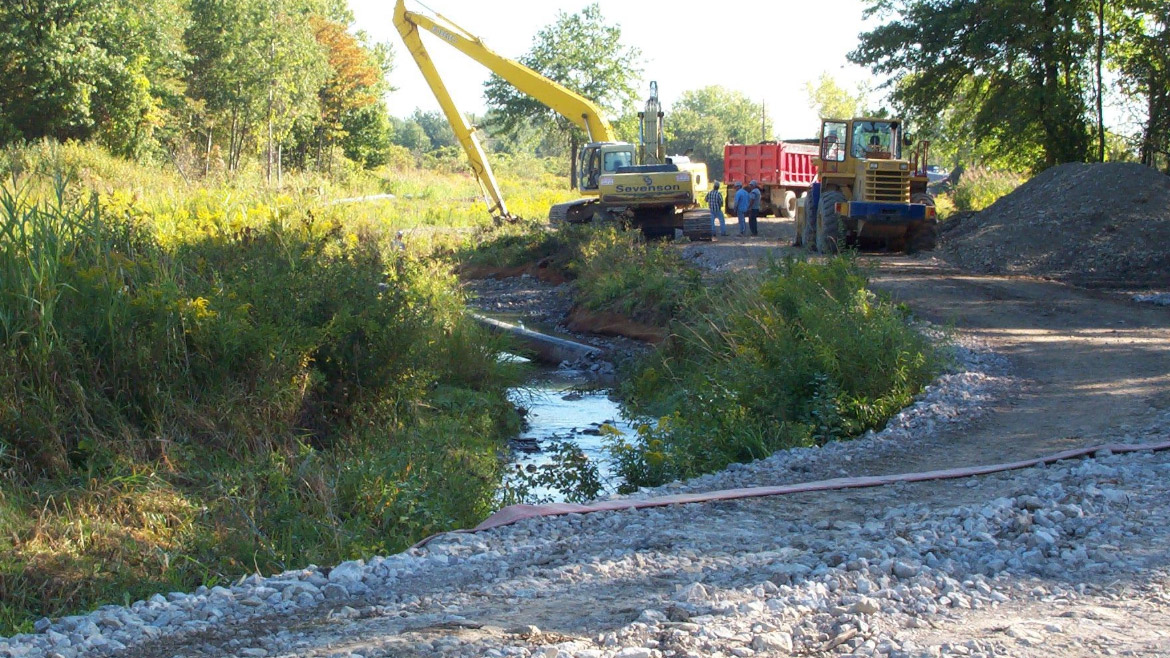GAO: EPA's Superfund Program Faces Funding Challenges Despite Recent Revival
New tax revenue provides lifeline as program shifts focus toward tech sector development and AI infrastructure needs

Cleanup operations at the Fields Brook Superfund site in Ohio demonstrate the complex infrastructure often present at contaminated sites. (Courtesy of the Department of Energy)
The Environmental Protection Agency's Superfund program, responsible for cleaning up America's most hazardous waste sites, has experienced a dramatic decline in funding over the past quarter-century, according to a new Government Accountability Office (GAO) report released this March.
The program's annual appropriations have plummeted from $2.6 billion in 1999 to approximately $537 million in 2024, raising concerns about the agency's ability to address the 1,340 contaminated sites currently on its National Priorities List (NPL).
However, a recent revival of Superfund taxes has injected new life into the program. In fiscal year 2023, the Treasury collected $1.44 billion in Superfund taxes, providing a substantial boost to the program's 2024 operations. This marks a significant shift as the program transitions to a combination of base funding and tax revenue, following the reinstatement of Superfund taxes in 2021 after a 26-year hiatus.
The funding challenges come at a critical time when these sites could play a vital role in America's technological future. As Remediation Technology recently reported, Congress is examining how contaminated industrial properties could be transformed into cutting-edge technology hubs, particularly data centers to support the growing artificial intelligence industry. With over 6,000 new data centers expected worldwide by the end of 2025, these sites' existing power infrastructure makes them particularly valuable for redevelopment.
"The sites remaining on the NPL are more complex and take more time and money to clean up," EPA officials noted in the GAO report. These sites, which include former manufacturing facilities, landfills, and mining operations, often contain dangerous contaminants such as polychlorinated biphenyls, lead, and arsenic. However, as James L. Connaughton recently testified before Congress, these challenges could become opportunities: "Many of these old thermal power plants, the old manufacturing centers... already have that intake and then discharge infrastructure. It's already been permitted in the past."
EPA’s Superfund Program Annual Appropriations, Fiscal Years 1999–2024

Key Challenges Identified
The cleanup efforts face multiple challenges beyond funding constraints. The GAO report specifically identified four major factors affecting cleanup timeliness:
- Discovery of new contaminants or changes in contamination extent
- Lack of potentially responsible parties for cost sharing
- Technical complexity, especially at contaminated sediment sites
- Limited agency resources, including decreased funds and regional staff
Recent cleanup reviews in the Northeast region have highlighted these ongoing challenges.
The Infrastructure Investment and Jobs Act provided some relief with a one-time injection of $3.5 billion in 2022. This funding boost comes as Congress considers new bipartisan legislation aimed at reviving tax incentives for brownfield cleanup, potentially providing additional resources for site remediation.
The situation echoes similar challenges faced during the 2009 financial crisis, when the American Recovery and Reinvestment Act provided an additional $600 million to bolster the program's efforts. Recent successful cleanups, such as the lead soil remediation in Northport and efforts to contain groundwater contamination at the Pasco landfill, demonstrate the program's continued importance despite funding challenges.
As the EPA continues to grapple with these complex cleanups, including emerging challenges like PFAS contamination, the effectiveness of the reinstated Superfund taxes and their impact on future cleanup efforts remains to be seen. The agency's ability to address these environmental hazards - and potentially transform them into technological assets - will likely depend on sustained funding and resources to tackle what has become an increasingly challenging portfolio of contaminated sites.
Scale of the Challenge: NPL Sites Nationwide
Of the 1,340 active sites on EPA's National Priorities List as of March 5, 2025, approximately 90 percent are nonfederal facilities. This represents a significant cleanup challenge that spans across various types of contaminated properties, from abandoned factories to hazardous waste dumps.
Historical Trends in Site Management
According to GAO's analysis of EPA data, both the addition of new sites to the NPL and the deletion of cleaned sites showed a general decline from fiscal year 1999 through 2013. EPA officials attribute this trend not only to reduced funding but also to the increasing complexity of remaining sites, which require more time and resources to remediate.
Program Funding Sources and Evolution
The Superfund program historically drew from multiple funding streams, including:
- Direct appropriations from Congress
- Environmental taxes (expired in 1995, reinstated in 2021)
- Cost recovery from responsible parties
- Supplemental funding through special legislation
The 2021 tax reinstatement marks a significant shift in the program's funding structure, potentially providing more stable resources for future cleanups. The $1.44 billion collected in fiscal year 2023 represents the first full year of collections under the reinstated tax system.
Supplemental Funding Impact
The program has benefited from several major supplemental funding initiatives:
- $600 million from the American Recovery and Reinvestment Act (2009)
- $3.5 billion from the Infrastructure Investment and Jobs Act (2022)
These one-time injections of funding have helped address immediate cleanup needs, but don't resolve the long-term funding challenges identified in the GAO report.




